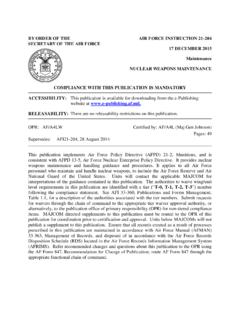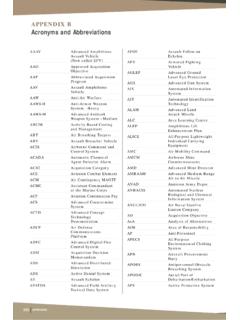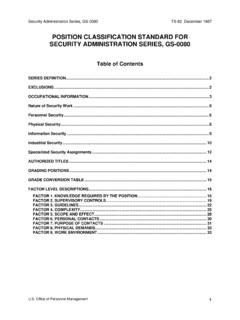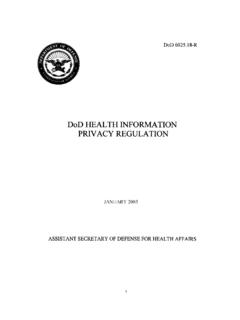Transcription of Defense Threat Reduction Agency
1 Defense Threat Reduction AgencyDefense nuclear weapons School QUICK LOOKUPR egistrar Phone: 505-846-5666 DSN: 246-5666 Fax: 505-846-9168 DSN: 246-9168 JPAS SMO Code: GQDD614 ATTN: DNWS Registrar, TSgt Shalanda Capehart Website (must connect via a .mil or .gov domain)Email: Asked Questions NumbersKirtland AFB, Albuquerque, NMAF INN:Phone 505-846-9653 DSN: 246-9653 Headquarters, Fort Belvoir, VAFT Belvoir LodgingPhone: 703-704-8600 or 1-800-295-9750 View from McDonald Ranch House - Trinity Site - 2014 Photo by: LT Michael McGonagle2 General InformationGeneral Information3 GENERAL INFORMATIONDNWS Overview ..4 Non-Attribution Policy ..5 DNWS Field Training Sites ..6 DNWS College Credits ..7 College and University Partnerships ..8 Certification Programs ..10 Class Schedule - including Mobile Training Team information ..16 nuclear weapons Instructional Museum ..18 DISTANCE LEARNINGDOD nuclear weapons Security (NWST).
2 20 nuclear weapons Instruction Museum Virtual Tour (NWIM Tour) ..21 Trinity Virtual Tour (Trinity Tour) ..22 Introduction to weapons of Mass Destruction in the 21st Century (WMD-21) ..23 DOD Personnel Reliability Program (PRP) ..24 nuclear Emergency Team Operations Primer (NETOPS Primer) ..25 nuclear Safety Studies and Review (NSSR) ..26 nuclear weapons Surety (NWS) ..27 Basic Scientific Calculator Skills (SciCal-101) (Calculator) ..28 Applied Radiological Response Techniques Level 1 (ARRT-1) ..29 Joint nuclear weapons Publications System (JNWPS) ..30 nuclear WEAPONSN uclear weapons Technical Inspections Course (NWTIC) .. Army nuclear and Counterproliferation Officer Course (NCP-52) ..33 nuclear weapons Orientation Course (NWOC) ..34 Advanced weapons Operators Course (AWOC) ..35 Joint DOD-DoE nuclear Surety Executive Course (JNSEC) ..36 Theater nuclear Operations Course (TNOC) ..37 nuclear Policy (NUCPOL).
3 38 nuclear RESPONSEN uclear Emergency Team Operations (NETOPS) ..40 Joint nuclear Explosive Ordnance Disposal (JNEODC) ..42 Advanced Diagnostics Training 1 (ADT-1) ..43 Advanced Diagnostics Training 2 (ADT-2) ..44 Introduction to Radiological and nuclear Incident Response (IRNIR) ..45 Applied Radiological Response Techniques Level 2 (ARRT-2) ..46 Applied Radiological Response Techniques Level 3 (ARRT-3) ..47 nuclear weapons Incident Response Training, Basic (NWIRT) ..48 NWIRT Executive Course (NWIRT-E) ..49 CBRN MODELING Advanced System Survivability Integrated Simulation Toolkit Level 1 (ASSIST) ..51 Geospatial Analysis for Consequence Assessment (GACA) ..52 Intermediate Modeler Course (IMC) ..53 Hazard Prediction and Assessment Capability Level 1 (HPAC-1) ..54 Hazard Prediction and Assessment Capability Level 2 (HPAC-2) ..55 Integrated weapons of Mass Destruction Toolset (IWMDT) Consequence Assessment (CA).
4 56 Basic Joint Effects Model Operator Course (JEM) ..57 Integrated Munitions Effects Assessment Level 1 (IMEA-1)..58 Integrated Munitions Effects Assessment Level 2 (IMEA-2)..59 Vulnerability Assessment Protection Options Level 1 (VAPO-1) ..60 Vulnerability Assessment Protection Option Level 2 (VAPO-2) ..61 HOSTED COURSESD efense Integration and Management of nuclear Data Services (DIAMONDS) ..64 Joint CWMD Planning Course (JCPC) ..65 PARTNERSHIP TRAINING AND EDUCATION PROGRAMP artnership Training and Education Program Modules (PTEP) ..67 USAF CENTER FOR UNCONVENTIONAL weapons STUDIESAir Force nuclear Fundamentals Course ( nuclear 200) ..72 Advanced nuclear Concepts Course ( nuclear 300) ..73 Senior Leader nuclear Management ( nuclear 400)..74 Air Force nuclear Certification Process Course ..75 Air Force nuclear Certified Equipment Users Course ..76 INFORMATION ANALYSIS CENTERD efense Threat Reduction Information Analysis Center (DTRIAC).
5 78 ADMINISTRATIVE ITEMS, FORMS and MAPSHow to Register for Classes ..83 DNWS Course Registration Form ..86 Request Letter to DNWS for Mobile Training Team Course ..87 Funding Authorization Letter to DNWS for Mobile Training Team Course ..88 DOE Request for Visit or Access Approval Form ..89 NWIM Tour Request Letter ..90 Map for DNWS, Kirtland AFB, Albuquerque, NM ..91 Map for DTRA Ft. Belvoir VA ..92 Map for CBRN Classes at Cubic, Alexandria, VA ..93 TABLE OF CONTENTS4 General InformationGeneral Information5 DNWS OverviewThe Defense nuclear weapons School (DNWS), in existence since 1947, is lo-cated on Kirtland AFB, Albuquerque, New Mexico. This Defense Threat Reduc-tion Agency school is a unique entity that provides training in nuclear weapons ; chemical, biological, radiological and nuclear incident command, control and response, chemical, biological, radiological and nuclear (CBRN) modeling for the Department of Defense (DOD), other federal, state, and local agencies.
6 In addition, this school manages and operates the only DOD classified nuclear weapons instructional museum (NWIM). The NWIM is an irreplaceable repository that traces the history and development of the nuclear weapons stockpile from its inception to the present and displays examples of all stockpiled nuclear weapons and their associated components and delivery systems, as well as related training aids. Tours are provided in conjunction with some courses conducted at the DNWS and vary in length from two to four hours depending on the audience. Arrangements can be made for groups and visitors to tour the NWIM on Tuesdays, Wednesdays, and Thursdays only. Classified tours require a DOD Secret security clearance with Restricted Data or Critical nuclear weapons Design Information access or a Department of Energy "Q" clearance to participate. An unclassified tour is also available upon request.
7 To solicit a special tour of the NWIM, a written request must be submitted and received a minimum of 15 working days before the scheduled tour date. Download a sample NWIM tour request letter or locate the form in the DNWS print Phillip A. Layman, Commandant, Defense nuclear weapons SchoolNon-Attribution PolicyThe Defense nuclear weapons School offers its assurances that presentations and discussions will be held in strict confidence. Without the expressed permission of the speaker, nothing will be attributed directly or indirectly in the presence of anyone who was not authorized to hear or view the presentation. Unclassified information gained during lectures, briefings, presentations, and discussions may be used freely. However, neither the speaker nor any element of the Defense nuclear weapons School may be identified as the orig-inator of the information without G. Conner,Chief Operations Officer, Defense nuclear weapons SchoolMission: The mission of the DNWS is to provide nuclear weapons core competencies and response training for weapons of mass destruction and CBRN incidents to DOD, national laboratories personnel, and other federal, state, and local Objectives: The school's training objectives are to create, develop, and implement professional training through both traditional methods and innovative training technologies.
8 DNWS training helps to ensure that our nation maintains a safe, reliable, and credible nuclear deterrent and a robust incident response : The DNWS delivers instructor-led courses in-residence and via Mobile Training Teams (MTTs) and offers distance learning courses online. The DNWS catalog includes 38 courses and 24 partnership modules. While most courses are taught in-residence at the DNWS, an expanding array of courses is offered via distance learning or MTT. The DNWS also hosts courses presented by the Army nuclear and CWMD Agency and the Air Force nuclear weapons Center, providing facilities, instructors, subject matter expertise, and administrative support. Ad-ditionally, the DNWS provides experts who teach modules within courses taught by other federal entities such as the Department of State and the Federal Bureau of : The Manhattan Engineer District, which developed the world's first atomic bomb, established the Nu-clear weapons Technical Training Group under the Armed Forces Special weapons Project in January 1947.
9 The Group's mission was "to provide training, both resident and non-resident, in support of nuclear weapon training programs worldwide; to be responsive to requests for training services and support required to meet the needs of all DOD components and other cognizant agencies." The nuclear weapons Technical Training Group later became the Special weapons School located on the Army's Sandia Base, today part of Kirtland Air Force 1971, the Defense nuclear Agency (DNA) was directed to transfer the Special weapons School to the Air Force, which renamed it the Interservice nuclear weapons School. In 1993, the school was transferred back to DNA and was subsequently renamed the Defense nuclear weapons School in 1997. DNA is a DTRA legacy its history, DNWS has supported the Office of the Secretary of Defense , the Joint Chiefs of Staff, the military Services, and the Combatant Commands by providing training, advice, and services in the field of nuclear DNWS operates DOD's only radiological training sites.
10 These sites are thorium-seeded fields that DNWS instruc-tors use as an integral part of field training for radiological emergency team members. DNWS conducts a variety of radiological accident exercises at these training sites, providing a realistic environment where students can apply their classroom knowledge. Students receive hands-on instruction and experience in the use of radioactivity monitor-ing instruments, the proper donning of personal protective equipment, and the collection of airborne radioactivity samples; in procedures for cleaning, inspecting, and proper wear of respirator protection; and in the setup and operation of contamination control stations. Students must integrate various modules of classroom instruction into intricate scenarios and determine what steps and equipment are InformationGeneral Information7 Defense nuclear weapons School Field Training SitesThe Defense nuclear weapons School (DNWS), part of the Defense Threat Reduction Agency (DTRA), is located on Kirtland Air Force Base, Albuquerque, New Mexico.











